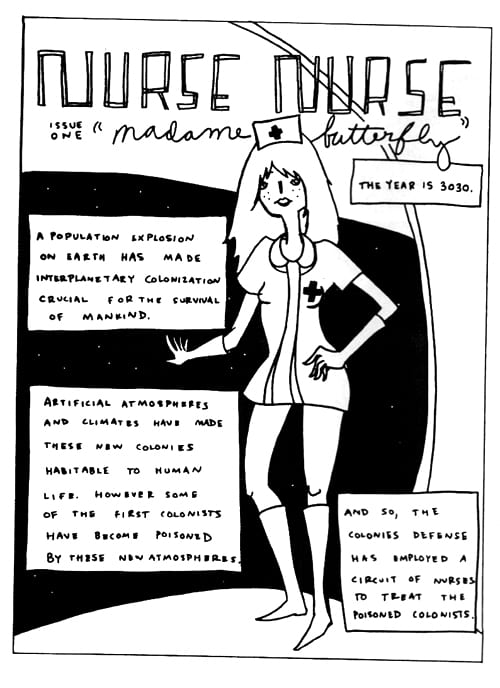Not quite there, this one, although there’s much to appreciate before it comes up short. Katie Skelly has an endearing cartooning style, an unlikely hybrid between Junko Mizuno and John Porcellino. While they’re in motion — and in this Barbarella-esque, demurely sexy sci-fi spaceship romp, that happens fairly frequently — her characters have a fluid, curving quality to them. Their designs are usually pretty strong, too. The title character, a young interplanetary nurse named Gemma whose inaugural assignment to treat colonists poisoned by alien atmospheres that goes badly wrong right out of the gate, and her eventual rescuer, a Inuit-like Martian named Träume, are strong enough that Skelly’s choice to duplicate them with clones and identical siblings is a delight in and of itself; the furious, furry black-and-white space pirate Pandaface has such a cool design I want to steal it wholesale.
Skelly’s uniform-weight line, which improves over the course of the eight issues of minicomics collected here, allows her to delineate the large white spaces that serve as the title character’s hair and stylish uniform, or the wings of butterflies, or fields of Martian snow, with ease and elegance. Those well-designed blobs of negative space are an indication that she’s at her best at her most graphically inventive — the covers of each issue, and a slew of psychedelic experiences, often make use of a vibratory black-and-white patterning that suggests a lo-fi Steranko.

I wish the story itself had this much going for it. Skelly’s emphasis is on world-building, not the rigorously planned concordance-requiring sort of Tolkien and his innumerable imitators but the simple pleasures of tossing out big bold SF ideas on every page. However, whereas most such stories are content to use their big ideas as set dressing, here the ideas are thrown not just fast but hard — they impact the story, they are directly addressed as mysteries by Gemma and her companions, they alter the course of the narrative, they’re brought back up and referred to multiple times. (An unfortunate side effect of this is a lot of panels of Gemma talking to people with a concerned look on her face; turns out Skelly’s characters are like sharks in that they need to keep moving for the designs to survive, and the still, talking-heads sequences reveal weaknesses in her figure work.) All of this means the story’s pretty much obligated to deliver on at least some of them or we’ll feel like we saw a bunch of stuff happen without any emotional or intellectual understanding of why.
Unfortunately, that’s exactly how we end up. By the time you hit the final chapter and Gemma’s still uncovering further wrinkles in her story, still traveling to new planets for the first time, still dodging various pursuers in “this isn’t over!” fashion, you realize there’s no way this thing can wrap up satisfactorily. We’ve seen the contours of a vast Alien-meets-Blade Runner conspiracy in which a shadowy agency sent Gemma to collect a vital alien substance without ever telling her she’s just some kind of clone, but if that’s the case, why does the same agency run a hit television show based so clearly on Gemma’s exploits that their patsy can’t help but realize she’s part of something much bigger than she’d thought? Is there any import behind her encounters with an ex-boyfriend from med school turned space pirate, or a famous rock band now in hiding on the planet to which she fled, for dodging the draft on the planet from which she fled? Why do we cut back to Träume and her guru-like scientist father for them to have a tearful meditation session just when Gemma’s story seems to be resolving satisfactorily? If there’s any rhyme or reason to any of this it’s not communicated on the page, despite a structure and tone that conditions us to expect partial resolution at the very least.

The best Skelly can offer as the pages dwindle to a close is a wink at the fourth wall, as Gemma’s mysterious (there’s that word again) pirate ex records a message for her. “There’s probably a lot you need explained,” he tells her, and clearly us as well. “Maybe you guessed a few things right. And I’d tell you what I know, but really, what’s the point?” Here, I’ll answer that: It’s to give this skeleton muscle. The parts are lovely, but there’s a hole in the whole where the “why” should be. Fittingly enough, the pirate deletes the message without sending it. Transmission incomplete.







